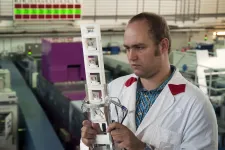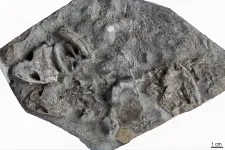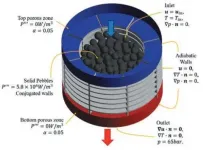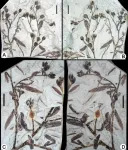Darwin foreshadowed modern scientific theories
2021-05-21
(Press-News.org) When Charles Darwin published Descent of Man 150 years ago, he launched scientific investigations on human origins and evolution. This week, three leading scientists in different, but related disciplines published "Modern theories of human evolution foreshadowed by Darwin's Descent of Man," in Science, in which they identify three insights from Darwin's opus on human evolution that modern science has reinforced.
"Working together was a challenge because of disciplinary boundaries and different perspectives, but we succeeded," said Sergey Gavrilets, lead author and professor in the Departments of Ecology and Evolutionary Biology and Mathematics at the University of Tennessee, Knoxville.
Their goal with this review summary was to apply the framework of modern speciation theory to human origins and summarize recent research to highlight the fact that Darwin's Descent of Man foreshadowed many recent scientific developments in the field.
They focused on the following three insights:
1. We share many characteristics with our closest relatives, the anthropoid apes, which include genetic, developmental, physiological, morphological, cognitive, and psychological characteristics.
2. Humans have a talent for high-level cooperation reinforced by morality and social norms.
3. We have greatly expanded the social learning capacity that we see already in other primates.
"The paper's insights have important implication for understanding behavior of modern humans and for developing policies to solve some of the most pressing problems our society faces," Gavrilets said.
Gavrilets is director of the Center for the Dynamics of Social Complexity (DySoC) at UT, which promotes transdisciplinary research into the origins, evolution, and futures of human social complexity. This paper is one of the outcomes of activities from the Center. Other related outcomes include free online learning modules on cultural evolution and a series of online webinars about cultural evolution and human origins, which thousands of students and researchers worldwide have watched.
INFORMATION:
Co-authors are Peter Richerson, a cultural evolutionist with the Department of Environmental Science and Policy at the University of California, Davis, and Frans de Waal, a primatologist with Living Links, Yerks National Primate Research Center at Emory University in Atlanta, Georgia.
The paper was sponsored by the UT National Institute for Mathematical and Biological Synthesis with an NSF award. Researchers also received support from the US Army Research Office, the Office of Naval Research, the John Templeton Foundation, and the NIH.
ELSE PRESS RELEASES FROM THIS DATE:
2021-05-21
CLEVELAND - Follow-up data from the landmark SPRINT study of the effect of high blood pressure on cardiovascular disease have confirmed that aggressive blood pressure management -- lowering systolic blood pressure to less than 120 mm Hg -- dramatically reduces the risk of heart disease, stroke, and death from these diseases, as well as death from all causes, compared to lowering systolic blood pressure to less than 140 mm Hg. Systolic blood pressure (SBP) is the upper number in the blood pressure measurement, 140/90, for example.
In findings published in the May 20, 2021 issue of the New England Journal of Medicine, investigators presented new evidence of the effectiveness of reducing SBP to a target range of less than 120 ...
2021-05-21
Depressive disorders are among the most frequent illnesses worldwide. The causes are complex and to date only partially understood. The trace element lithium appears to play a role. Using neutrons of the research neutron source at the Technical University of Munich (TUM), a research team has now proved that the distribution of lithium in the brains of depressive people is different from the distribution found in healthy humans.
Lithium is familiar to many of us from rechargeable batteries. Most people ingest lithium on a daily basis in drinking water. International studies have shown that ...
2021-05-21
Beijing, 19 May 2021: the journal Cardiovascular Innovations and Applications (CVIA) has just published a new issue, Volume 5 Issue 4.
This issue brings together important research from leading cardiologists in US and China in a combination of reviews, original research and case reports.
REVIEWS
Pei Huang, Yi Zhang, Yi Tang, Qinghua Fu, Zhaofen Zheng, Xiaoyan Yang and Yingli Yu
Progress in the Study of the Left Atrial Function Index in Cardiovascular Disease:
A Literature Review (https://tinyurl.com/3vruva37)
Nikhil H. Shah, Steven J. Ross, Steve A. Noutong Njapo, Justin Merritt, Andrew Kolarich, Michael Kaufmann, ...
2021-05-21
Social scientists have had a longstanding fixation on moral character, demographic information, and socioeconomic status when it comes to analyzing crime and arrest rates. The measures have become traditional markers used to quantify and predict criminalization, but they leave out a crucial indicator: what's going on in the changing world around their subjects.
An unprecedented longitudinal study, published today in the American Journal of Sociology, looks to make that story more complete and show that when it comes to arrests it can come down to when someone is rather than who someone is, a theory the researchers refer to as the birth lottery of history.
Harvard sociologist Robert J. Sampson and Ph.D. candidate Roland Neil followed arrests in the lives of more than ...
2021-05-21
Paleontologists had to adjust to stay safe during the COVID-19 pandemic. Many had to postpone fossil excavations, temporarily close museums and teach the next generation of fossil hunters virtually instead of in person.
But at least parts of the show could go on during the pandemic -- with some significant changes.
"For paleontologists, going into the field to look for fossils is where data collection begins, but it does not end there," said Christian Sidor, a University of Washington professor of biology and curator of vertebrate paleontology ...
2021-05-21
When one of the largest modern earthquakes struck Japan on March 11, 2011, the nuclear reactors at Fukushima-Daiichi automatically shut down, as designed. The emergency systems, which would have helped maintain the necessary cooling of the core, were destroyed by the subsequent tsunami. Because the reactor could no longer cool itself, the core overheated, resulting in a severe nuclear meltdown, the likes of which haven't been seen since the Chernobyl disaster in 1986.
Since then, reactors have improved exponentially in terms of safety, sustainability and efficiency. Unlike the light-water reactors at Fukushima, which had liquid coolant and uranium ...
2021-05-21
"Abominable mystery" -- the early origin and evolution of angiosperms (flowering plants) was such described by Charles Robert Darwin. So far, we still have not completely solved the problem, and do not know how the earth evolved into such a colorful and blooming world.
Recently, a new angiosperm was reported based on numerous exceptionally well-preserved fossils from the Lower Cretaceous of Jiuquan Basin, West Gansu Province, Northwest China. The new discovery is the earliest and unique record of early angiosperms in Northwest China. The study has been accepted for publication in the journal National Science Review and is currently available online at https://doi.org/10.1093/nsr/nwab084.
The new angiosperm was named Gansufructus saligna, and all the fossil specimens ...
2021-05-21
Atmospheric ozone, which can regulate the amount of incoming ultraviolet radiation on the Earth's surface, is important for the atmospheric environment and ecosystems. Tropospheric ozone, primarily originating from photochemical reactions, is the third most prominent greenhouse gas causing climate warming.
A research team led by Dr. Jinqiang Zhang from the Institute of Atmospheric Physics (IAP) of the Chinese Academy of Sciences tried to analyze vertical ozone distributions and explore the influence of deep stratospheric intrusions and wildfires on ozone variation in the northern Tibetan Plateau (TP) during the Asian summer monsoon period.
Their findings were published in Atmospheric Research.
Ozone variation over the TP can influence weather and climate change. ...
2021-05-21
Researchers from the University of Surrey have revealed a new method that enables common laboratory scanning electron microscopes to see graphene growing over a microchip surface in real time.
This discovery, published in ACS Applied Nano Materials, could create a path to control the growth of graphene in production factories and lead to the reliable production of graphene layers.
Dispensing with the use of expensive bespoke systems, the new technique not only produces graphene sheets reliably but also allows to use fast-acting catalysts that reduce growth times from several hours to only a few minutes.
With the use of video imagining, the team from Surrey's Advanced Technology Institute (ATI) have shown graphene growing over an iron catalyst, using a silicon nitride ...
2021-05-21
Sloughed off skin and bodily fluids are things most people would prefer to avoid.
But for marine biologist like Cheryl Lewis Ames, Associate Professor of Applied Marine Biology in the Graduate School of Agricultural Science at Tohoku University (Japan), such remnants of life have become a magical key to detecting the unseen.
Any organism living in the ocean will inevitably leave behind traces containing their DNA - environmental DNA (eDNA) - detectable in water samples collected from the ocean
Only recently has molecular sequencing technology become ...
LAST 30 PRESS RELEASES:
[Press-News.org] Darwin foreshadowed modern scientific theories




